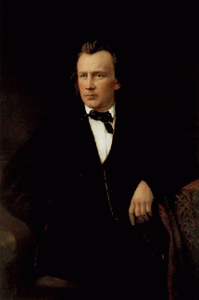
Johannes Brahms
This last symphony of Brahms was actually the first of all his symphonies I started with years ago, and it’s one of those pieces that have both the beauty of lyrical lines and the complexity of its texture and inner workings among motifs and themes. I never get tired of listening to it, and I’m sure many people share the same feeling.
There is a rare recording of Leonard Bernstein’s analysis in great detail on the first movement[1]. The key point Bernstein made in that lecture was that the essence of symphonic music is “development”. The term does not refer to mere development section of the sonata form, but the organic growth of even the most simple musical ideas, such as the fragmented 2-note intervals constituting the main theme of the first movement, throughout a movement and further the entire symphony. Evidently such “development” occurs right from the get go of a theme being presented, and the genius of Brahms lies in his very ability to “create something out of (almost) nothing”, as Bernstein commented.
1. Allegro non troppo
The main theme is heard right from the beginning of the first movement, serene and elegant, but also a bit unease due to the disconnected, up-down changing intervals:
Bernstein pointed out a few characteristics of this seemingly simple theme:
- A series of separated, 2-note groups; seems panting with breathlessness
- Presented in classical symmetry, as containing the passion in a mold: left & right, as if questions & answers
- Begins on the weak up-beat, shows agitation with pulse
- Passionate quality is bolstered by accompaniment lower string’s wide-range arpeggios, like surging waves
The theme is first played by the violins in merely 8 bars, but is immediately developed for over 40 bars, until a transitional theme enters by the woodwinds, emphasizing on the dotted rhythm in anticipation of that same pattern in the second theme that follows:
The 2nd theme has two parts; the first part, played by cellos and horns, contrasts the first theme with a heavy rhythm almost sounding like a German tango, as Bernstein noted:
The second part on the woodwind:
The remainder of the movement is pure magic, as noted by Malcolm MacDonald, “powerfully organic and continuously unfolding”; the emotional build-up seems unstoppable, by the end of the coda the main theme that is “saturated in regret has taken on resolve”[2]. Just listen to the ending that erupts like this:
and reaches climax with such firm resolve:
2. Andante moderato
After an energetic first movement, Brahms brings us back to an emotional episode of reflection and melancholy in the second movement. Some program note considers the horn opening of the first theme “forceful”, I’m not sure about that. It certainly comes with a steady pace, but what I hear sounds more like the composer’s deep thoughts in solitude rather than forceful outward statement. Here’s the introduction led by the horn and then oboe:
It is immediately followed by the main theme played by woodwinds:
The mood that follows starts to stir up moderately, marked by the triplets on the woodwinds; then the second theme is poured out by the strings, warm yet filled with somewhat bitter sweet memory:
Though later the recapitulation comes back on the two themes with stronger emotion, overall this is a movement much held back contrasting to the passionate first movement.
3. Allegro giocoso
Listening to the exuberant opening of the third movement, one would ask “where did all these upbeat excitements come from all of a sudden”? Given what comes before and after it, the scherzo does seem a bit out of place. Some say this is because we, the audience, would “need some relief from the unremitting seriousness of the first two movements”[3]. Would Brahms be that considerate while writing his last symphony, or was he simply honoring his devotion to the classical form? I don’t know.
The first theme is considered to have three parts. Part A:
Part B:
And Part C:
The 2nd theme quiets down and is played by the strings, then echoed by woodwinds:
4. Allegro energico e passionato
The finale has been considered the highest culmination of Brahms’s ingenious composition talent, his deep emotional struggle, and ultimately his darkest view of the world. Unlike all of his previous symphonies, the final movement ends on a minor key. And above all, probably the most unusual aspect of this movement is that, the composer’s strongest emotional outburst confined within the strictest baroque form passacaglia, a series of variations over a recurrent bass. As Bernstein pointed out, this is yet another evidence of Brahms’s duality rooted deep in his music style and personality, just as evident in his other three symphonies.
The main theme, basis of 32 variations in this movement, is loudly proclaimed by the brass:
It is common belief that Brahms arranged the variations in a structure somewhat similar to a sonata form. After the theme is presented and followed by a few variations, variation 12 enters a quieter period, led by solo flute, which could be considered 2nd part of the exposition:
When the main theme is repeated in variation 16, we could consider the movement starts the development section:
The psudo-recapitulation part starts at variation 24, which along with the two variations after refer back to variation 1 through 3:
With the brass shouting out the original theme’s 8 upward stepping notes, and strings slashing answers on the middle beat, Bernstein viewed this as “passionate rage” and “desperate fury” from Brahms[4].
By the end of the variations, the coda starts by reiterating the main theme:
Bernstein described the finale ends in “rage and fury”, “no final repose, no glorious sunburst in the major mode”; Brahms’s “last symphonic statement is that clenched fist raised in hot defiance to the heavens”. So here’s that “brief but shattering” final ending[5]:

